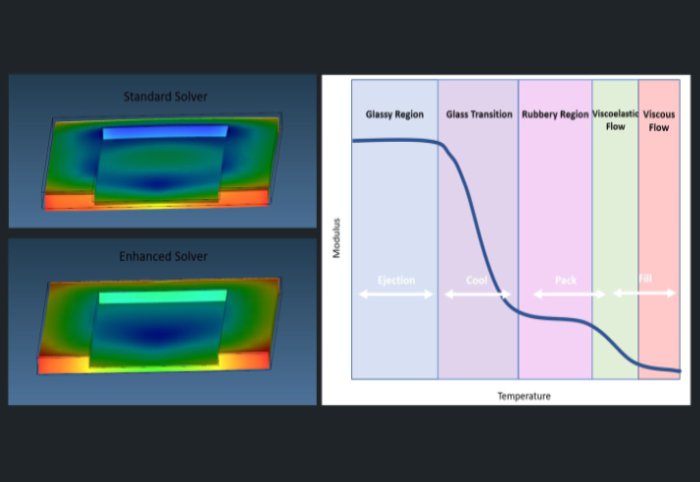
Consideration of viscoelasticity in warpage calculations
ESPAECIALLY FOR OUR USERS
The warpage calculation in Moldex3D is sufficiently accurate for most of the standard simulations. However, when the temperature and pressure vary rapidly at the end of the packing phase, the warpage tends to be overpredicted. Therefore, in Moldex3D there is the option of enhanced-solver for warpage calculations. Read the following to see the advantages, challenges, and their solutions when using this solver.
During the injection molding process, the polymer undergoes various phases of property changes during the flow process and the subsequent cooling phase (shown in the diagram in the above picture on the right). In the filling phase, the polymer is in its viscous phase and during packing, it also acquires an elastic behavior when heat is released under high pressure. Further cooling transforms the polymer into a rubber-like plastic and finally reaches a glass-like state (read more in SimpaTec's Expert Tip).
In order to calculate the warpage in Moldex3D, the standard solver calculates it taking the volumetric shrinkage into account but not considering the viscoelastic properties from the end of the cooling phase. This may result in an overprediction of the warpage (see above picture on the left). In order to be able to simulate exact results for such calculations, Moldex3D offers the possibility to include the structural viscoelastic material properties in the warpage calculation.
The "enhanced solver" contains the following criteria:
_ In-Mold-Constraints (IMC) in the cooling phase,
_ Viscoelastic effect during the solidification process
_ Transient Temperature Effect
In addition, the "enhanced solver" can predict the residual stresses of ejected parts, while the viscoelastic effect and the in-mold constraints are applied to the individual time steps during the cooling phase.
For these calculations the corresponding material information is necessary. This must be verified in advance when using the functions. If the viscoelastic material data is not available or only "generic", the data should be requested from the respective manufacturer or, if not available, characterized. In both cases SimpaTec will be pleased to provide you with the necessary support.
